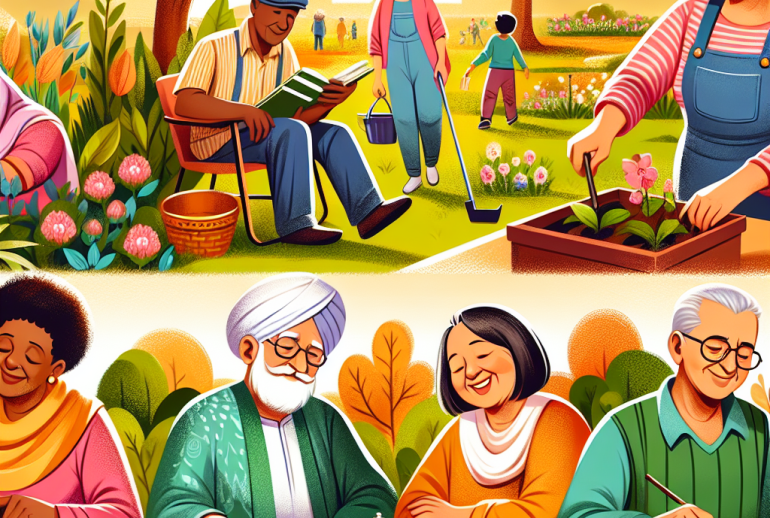Building a Strong Community of Seniors
In today’s fast-paced world, fostering a sense of community among seniors is more important than ever. As people age, the need for social interaction and support networks becomes crucial for maintaining mental, emotional, and physical well-being. Building a strong community for seniors not only helps them stay connected and active but also enriches their lives in numerous ways. This blog post delves into the strategies and benefits of creating vibrant senior communities, with a focus on practical steps and inspiring success stories.
The Importance of Community for Seniors
As individuals age, their social networks often shrink due to retirement, the passing of friends and relatives, and potentially increased physical limitations. This isolation can lead to feelings of loneliness and depression, which, in turn, can have adverse effects on physical health. Studies have shown that seniors with robust social connections tend to live longer and have better overall health. They are more likely to engage in physical activities, eat healthily, and attend regular medical check-ups.
A strong community provides seniors with a sense of belonging and purpose. It encourages them to engage in activities that stimulate their minds and bodies. Moreover, it creates an environment where they can share experiences and support each other, greatly enhancing their quality of life.
Strategies for Building a Senior Community
Create Senior-Friendly Spaces
The foundation of any strong senior community is a series of accessible and welcoming spaces. Here are some ways to create such environments:
- Ramps and Elevators: Ensure that buildings and outdoor areas have ramps and elevators for easy access.
- Comfortable Seating: Provide plenty of comfortable seating options in communal areas.
- Natural Light: Incorporate large windows and open spaces that allow for natural light, which can improve mood and well-being.
Promote Intergenerational Activities
Intergenerational activities can help bridge the gap between different age groups and foster mutual understanding and respect. Here are some ideas:
- Mentorship Programs: Allow seniors to mentor younger individuals, sharing their wisdom and experience.
- Community Service: Organize community service projects that involve both seniors and younger volunteers.
- Family Days: Host events where families can participate together, encouraging interaction between seniors and younger generations.
Organize Social and Recreational Activities
Regular social and recreational activities keep seniors engaged and active. Here are some suggestions:
- Fitness Classes: Offer classes like yoga, tai chi, or water aerobics that cater to different fitness levels.
- Art and Craft Workshops: Encourage creativity with painting, knitting, or pottery classes.
- Book Clubs: Foster intellectual stimulation and discussion through book clubs.
- Game Nights: Organize game nights with bingo, card games, or board games.
Leverage Technology
In today’s digital age, technology can play a significant role in building senior communities. Here’s how:
- Virtual Meetups: Use video conferencing tools to facilitate virtual meetups and keep seniors connected, especially those who are homebound.
- Social Media Groups: Create social media groups where seniors can share information, photos, and updates.
- Educational Programs: Offer classes to teach seniors how to use technology safely and effectively.
Success Stories: Examples of Strong Senior Communities
To understand the practical application of these strategies, let’s look at some success stories of senior communities that have flourished.
The Villages, Florida
The Villages, a retirement community in Florida, is a prime example of a thriving senior community. With over 120,000 residents, The Villages offers an extensive range of activities and clubs, from golf to gardening, ensuring there’s something for everyone. The community also prioritizes intergenerational interaction by hosting events that involve the broader family and local youth.
Trailside Senior Living, Minnesota
Trailside Senior Living in Minnesota leverages technology to keep its residents engaged and connected. They have a robust schedule of virtual activities, including exercise classes and book discussions. Technology is also used to facilitate regular check-ins and support health monitoring, ensuring the well-being of their residents.
OASIS Institute
The OASIS Institute emphasizes lifelong learning and enrichment for seniors across the United States. Offering classes, volunteer opportunities, and health programs, OASIS fosters a sense of community and purpose among its members. Their intergenerational tutoring program connects seniors with young students, benefiting both groups and reinforcing the valuable role of seniors in society.
The Role of Community Leaders and Volunteers
Building a strong community for seniors requires dedicated leaders and volunteers. Their roles include:
- Organizing Events: Planning and coordinating activities and events tailored to seniors’ interests and abilities.
- Providing Transportation: Helping seniors who have mobility issues to attend events and appointments.
- Offering Support: Being available for emotional support and companionship, especially for those living alone.
Training programs can help volunteers understand the unique needs of seniors and equip them with the skills to effectively support and engage with them. Recognition and appreciation of their efforts can also motivate volunteers and sustain their involvement in the community.
Overcoming Challenges
Building a strong community of seniors is not without challenges. Here are some common obstacles and ways to address them:
- Limited Resources: Seek partnerships with local businesses and organizations for funding and resource support.
- Health Issues: Provide flexible and inclusive activities that accommodate various health conditions and mobility levels.
- Resistance to Change: Encourage gradual participation and highlight the benefits of community involvement to overcome reluctance or resistance.
Conclusion
Creating and nurturing a robust community for seniors is a multifaceted endeavor that requires commitment, creativity, and collaboration. By providing accessible spaces, organizing diverse activities, leveraging technology, and fostering intergenerational connections, we can build vibrant communities that celebrate and empower our seniors. The benefits of such communities are profound, enhancing the well-being and happiness of seniors while enriching the broader society. It is an investment in the dignity and joy of individuals who have contributed so much over their lifetimes, ensuring they continue to live fulfilling and connected lives.

